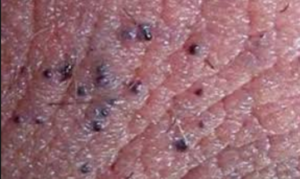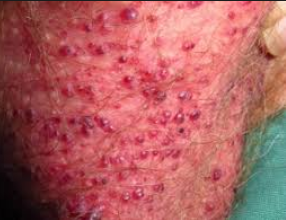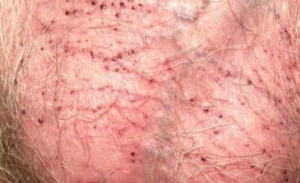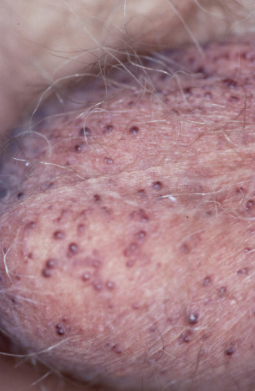What are the causes of blood blister on scrotum, testicles or balls? Blood blister on the balls are medically referred to as angiokeratomas. They can appear as small or tiny blisters. in some cases that won’t stop bleeding? In this page, we shall cover angiokeratomas of the scrotum. Find more on the causes, pictures and how to treat.

Blood blister on balls or scrotum are medically referred to as angiokeratomas. They are usually red or dark vascularized lesion on the scrotum skin. They can be localized or diffused. The diffuse type are commonly seen in people with Fabry’s disease. They are therefore rare type of scrotum blood blisters. This content will cover the angiokeratoma of the scrotum including pictures and how to treat.
Pictures
How do scrotum blisters look or appear like? Below is a picture that will give you a visual aid of this condition. More images are inserted throughout the post to help your understand even much better the cause of your symptoms.
What causes blood blister on scrotum, balls?
The appearance of blood blister on scrotum, balls and penis can be very bothersome for men. The blisters can be as results of several conditions. Some are through STIs or non- STIs. While most are harmless, it is wise to visit your doctor for treatment and better support.
1. Shaving
Generally blood blister on skin can occur as a result of minor trauma such as physical injury. Shaving the scrotum or balls can cause lesions or sores. Poor shaving methods, such as saving shaving close to the skin can results to blisters. This can be due to friction during shaving.
2. STD, Herpes
Having blood blisters on scrotum can be as a results of Sexually transmitted disease. Genital Herpes is one of them. It is caused by Herpes simplex virus acquired through contact. During initial stages of infection, HSV may have symptoms such as painful fluid – filled blisters on ulcers and genital areas. A burning or itching sensation is common. Treatment is based on the symptoms to give relief.
3. Bullous Impetigo
According to Wikipedia, this is a skin condition that is characteristically occurs in the newborns and it caused by bacteria infection presenting with bullae. The condition usually appear around the diaper region, axilla or neck. The lesion or vesicles increase in size to form the bullae, a blister that is more than 5mm. you may experience signs and symptoms such as itching, swelling of the nearby glands, fever and diarrhea. The blood blisters can be cure with oral antibiotics found over – the – counter.
4. Pemphigus Vulgaris
This is a rare autoimmune disease that forms blisters and lesions on the skin and mucous membranes. The areas likely to be affected include the lining of the mouth, nose throat and genitals. The blisters are generally painful, fragile and can easily burst open. The condition tend to affect people of all ages including children. Adults are worst victims. The condition isn’t contagious.
See your healthcare provider if the condition causes severe or persistent blood blisters on scrotum. If not treated, the condition can be fatal as a result of severe infection of the sores. Treatment involves controlling the condition with a combination of various medication to stop the immune system attacking the body. Steroid medication are used for a few weeks or months. This helps to stop new blisters from forming and gives the existing ones to heal.
5. Syphilis
Initial symptoms of syphilis can present itself as single painless blood blister on scrotum and penile shaft. Multiple cases of blisters or sores can be noticeable. The blisters will eventually go away on their own. However, the condition can still be in your body. If syphilis is left untreated, it can cause serious health complication affecting your heart, brain and other many other organs. A painless bump filled with fluid or blood should be checked. Early treatment can cure the condition completely.
Angiokeratoma of the scrotum
Also referred to as angiokeratoma of Fordyce, angiokeratoma of Mibelli or Scrotal angiokeratoma. This condition can be described as a benign condition. It results to lesions of capillaries of small red to blue or purple papules that are asymptomatic usually 2 to 5 mm in size. They can be noticed at early stage of adolescence but become visible with advancing in age. They are commonly seen on the scrotum. Other areas likely to be affected include the shaft of the penis, groins, glans and lower abdomen. In women, the condition is seen in labia.
The several types of angiokeratomas include:
- Sporadic angiokeratoma: This type of angiokeratoma consist of single lesion appearing in various areas. Most commonly found in men on the scrotum. The lesions may also occur on the shaft of the penis, inner thigh and lower part of the abdomen. Men the age of 40 years and above are most commonly affected.
- Angiokeratoma of Fordyce: although commonly found on the scrotum, the penis, labia, inner thigh and lower abdomen are also affected. It may appear as a single or multiple lesions. Usually small, red and slightly scaly in youth while increase in size, becoming blue/ black and with overlying scales. Although the condition is asymptomatic, it becomes visible when bleeding occurs after either scratching or intercourse.
- Angiokeratoma circumscription: they are vascular malformation present at birth. However, can occur later in childhood or adulthood. It is prevalent in females than men.
- Fabry disease: this is a rare but serious genetic disorder prevalent in male than females. You may experience fever, painful hands and feet.
What Causes angiokeratomas?
This is a male condition affecting boys and men of all ages. It is a common condition with the risk increasing as one advances in age. It is most commonly seen in men over the ages of 40 years. The exact cause is not known. The condition is not contagious. You cannot therefore get it or spread ton another individual. Other than Fabry disease that occurs as a results of genetic disorder, the cause is yet to be established.
What are the signs and symptoms of angiokeratoma?
The symptoms and signs of angiokeratomas of scrotum include:
- Appearance of small either single or multiple lesions
- Red or purple blisters or papules on the scrotum
- The scrotum skin may be thickened, scaly and can be infected with bacteria or fungus
- The infection can cause pus filled bumps
- Itching, soreness and painful blisters
Angiokeratoma of the scrotum pictures
Below find an image of blood blister on scrotum as a result of angiokeratomas. They are for illustrative purpose to help you understand the symptoms.


Angiokeratoma of the scrotum treatment
How are angiokeratomas of the scrotum diagnosed? Although the exact cause is not yet established, diagnosis is based on clinical examination of the lesion. Skin biopsy may be done just in case there is confusion to rule out other disease. The blood blisters are harmless lesion and do not necessarily need treatment. They are asymptomatic lesion and therefore can be left untreated.
In case, there’s itching, soreness and bleeding probably after scratching or intercourse, you may have it removed. It can be done possibly if there’s a cosmetic concern. There are several surgical treatment option available. They include:
- Excision: this is done to patients under local anesthesia
- Cryotherapy: it involves application of liquid nitrogen to resolve diffuse patterns of angiokeratomas of the scrotum
- Electrocautery: light electrocoagulation is usually done to remove lesions or blood blisters on scrotum
- Laser treatment
- Sclerotherapy
Blood blister on scrotum won’t stop bleeding
Having blood blister on scrotum is embarrassing. Your sex life is equally affected when there is bleeding. Angiokeratoma of the scrotum is prime cause of bleeding blisters. Itching, soreness and bleeding can happen especially if you scratch or rough intercourse. Although the blood blister on scrotum are usually harmless, you may consider removing. The several surgical treatment options have been discussed above under angiokeratomas.
Tiny, small red blood blister on scrotum skin
Small or tiny red sores or blisters on the scrotum skin are normal. Although they are bothersome, they are generally harmless. The small blisters are angiokeratomas. See pictures to have a better understanding. Angiokeratomas are either red or purple spots on testicles skin. Visit your healthcare provider to rule out other possible disease such as malignancy. Treatment is usually done where there’s bleeding or cosmetic concerns.
Itchy blood blister rash on scrotum sac and balls.
Itchy blister rash on scrotum can be a hard condition to live with. That persistent urge to scratch the blisters can lead to bleeding and sores. This risk possible entry of infections in the scrotum skin and balls. The possible causes of itching include STDs such as herpes. Angiokeratomas can also be associated with itching and soreness. You should visit your healthcare provider for medication to relieve the itching.
Treatment for blood blister on scrotum
Treatment for blisters or lesions on scrotum depend on the underlying cause. The blisters can be left alone if they are not causing any harm. Especially if the cause is angiokeratomas. Treat the Sexually transmitted disease such as genital herpes to heal the blisters. Read more under each cause to find the treatment options available for blisters. Surgical treatments are discussed under angiokeratomas. They are done if there’s bleeding, itching or soreness or cosmetic concern.
How to get rid of blood blisters on scrotum
Although blood blisters on scrotum causes no harm. You may do the following at home:
- Proper scrotal hygiene
- Do Not wear tight pants
- Do not scratch the blisters, this can results to bleeding and infection. Instead give the blisters time to heal
- Apply fresh gel from aloe plant on the blisters to stop itching
Sources and references:
- https://en.wikipedia.org/wiki/Angiokeratoma
- http://www.dovemed.com/diseases-conditions/angiokeratoma-scrotum/
- https://www.dermnetnz.org/topics/angiokeratomas
- http://emedicine.medscape.com/article/1056046-treatment
- http://www.nhs.uk/conditions/pemphigus-vulgaris/Pages/Definition.aspx
- http://www.dermnetnz.org/topics/pemphigus-vulgaris/
- http://www.geniderm.com/common-causes-of-blisters-on-penis/



